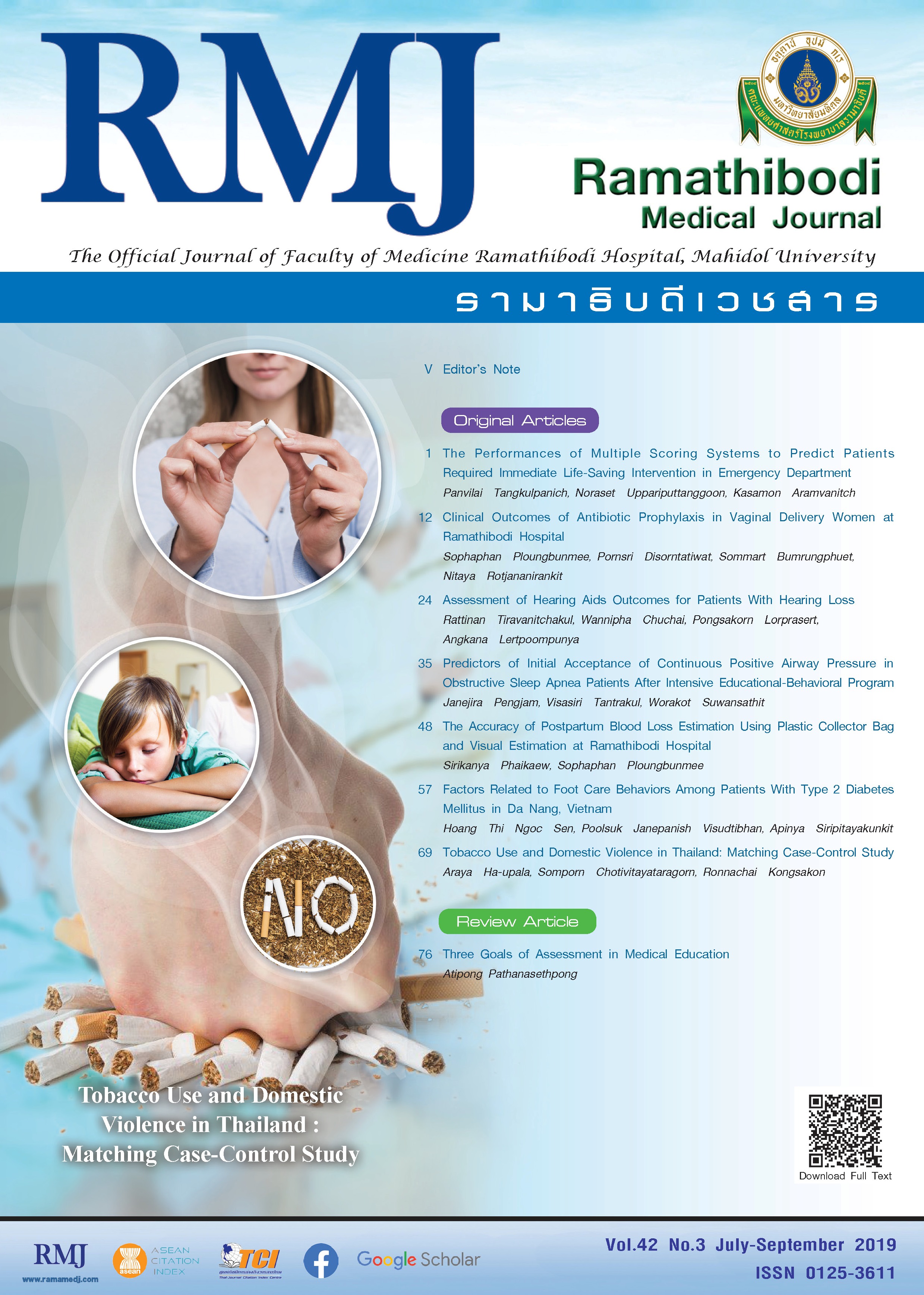Factors Related to Foot Care Behaviors Among Patients With Type 2 Diabetes Mellitus in Da Nang, Vietnam
Main Article Content
Abstract
Background: Foot ulceration and amputation have alarmingly increased among patients with type 2 diabetes mellitus in Vietnam. Poor foot care behavior is one of the crucial reasons which leads to diabetes related foot problems. Exploration factors related to foot care behaviors among people with diabetes becomes a necessary issue to limit this complication.
Objective: To determine factors related to foot care behaviors among patients with type 2 diabetes mellitus.
Methods: The descriptive correlation study was conducted in 140 participants by purposive sampling technique in the outpatient room of Da Nang Hospital, Da Nang, Vietnam from December 2017 to January 2018. Instrument used in the study included of the six cognitive impairment test, demographic form, the Nottingham assessment of functional foot care, foot care knowledge, foot care confidence scale, and foot care subscale in the social support scale for self-care in middle-aged patients with type 2 diabetes mellitus. Data were analyzed by chi-square test, Pearson product moment correlation coefficient, and Spearman rank correlation coefficient.
Results: Of 140 participants, 58.6% had poor foot care behaviors. Education level, foot care knowledge, foot care self-efficacy, and social support showed a statistically significant positive correlation with foot care behaviors. There was no significant correlation between age, gender, and foot care behaviors.
Conclusions: The study suggested that improving foot care knowledge, foot care behaviors and enhancing the role of nurses must be implemented for the improvement of foot care behaviors among patients with type 2 diabetes mellitus.
Article Details
References
International Diabetes Federation. IDF Diabetes Atlas 8th ed. Brussels, Belgium: International Diabetes Federation; 2017.
World Health Organization. The growing burden of diabetes in Viet Nam. 2016; https://www.wpro.who.int/vietnam/mediacentre/features/feature_world_health_day_2016_vietnam/en/. Acessed March 7, 2019.
Ministry of Health. National Strategy for the Prevention and Control of Non-Communicable Diseases (NCDs) for 2015 - 2025. Hanoi, Vietnam: Ministry of Health; 2015.
Baumann LC, Blobner D, Ta VB, Lan PT. A training program for diabetes care in Vietnam. Diabetes Educ. 2006;32(2):189-194. doi:10.1177/0145721706286569.
Ta VB. Diabetes Foot in Vietnam. J Diabetes Investig. 2010;1(1):21.
Doan TP, Schokebumroong K. Knowledge and practice regarding foot ulcer prevention in type 2 diabtetes patients at Hai Duong General hospital, Hai Duong province, Vietnam. J Nurs Sic Health. 2014;37(4):10.
Da Nang Statistics Department. Socio-economic situation of Da Nang city in 2016. 2017; https://www.cucthongke.danang.gov.vn/TabID/59/CID/2/ItemID/505/default.aspx.
Do IT, Tran HD, Ton TT, Nguyen NA, Tran DT. Risk prediction model for type 2 diabetes mellitus using finnish diabetes risk score (FINDRISC) among adult population in Da Nang city. VJPM. 2017;27(8):137-145.
Bandura A. Social cognitive theory: an agentic perspective. Annu Rev Psychol. 2001;52(1):1-26. doi:10.1146/annurev.psych.52.1.1.
Bandura A. Self-efficacy: toward a unifying theory of behavioral change. Psychol Rrev. 1977;84(2):191-215.
Cohen J. A power primer. Psychol Bull. 1992;112(1):155-159. doi:10.1037/0033-2909.112.1.155.
Li R, Yuan L, Guo X-H, et al. The current status of foot self-care knowledge, behaviours, and analysis of influencing factors in patients with type 2 diabetes mellitus in China. Int J Nurs Sciences. 2014;1(3):266-271. doi:10.1016/j.ijnss.2014.05.023.
Brooke P, Bullock R. Validation of a 6 item cognitive impairment test with a view to primary care usage. Int Geriatr Psychiatry. 1999;14(11):936-940.
Lincoln NB, Jeffcoate WJ, Ince P, Smith M, Radford KA. Validation of a new measure of protective footcare behaviour: the Nottingham assessment of functional footcare (NAFF). Practical Diabet Int. 2007;24(4):207-211. doi:10.1002/pdi.1099
Sloan HL. Developing and testing of the foot care confidence scale. J Nurs Meas. 2002;10(3):207-218. doi:10.1891/jnum.10.3.207.52564
Naderimagham S, Niknami S, Abolhassani F, Hajizadeh E, Montazeri A. Development and psychometric properties of a new social support scale for self-care in middle-aged patients with type II diabetes (S4-MAD). BMC Public Health. 2012;12(1):1035. doi: 10.1186/1471-2458-12-1035.
Martini J, Huertas C, Turlier V, Saint-Martory C, Delarue A. Efficacy of an emollient cream in the treatment of xerosis in diabetic foot: a double-blind, randomized, vehicle-controlled clinical trial. J Eur Acad Dermatol Venereol. 2017;31(4):743-747. doi:10.1111/jdv.14095.
Gonzalez-Zacarias AA, Mavarez-Martinez A, Arias-Morales CE, Stoicea N, Rogers B. Impact of demographic, socioeconomic, and psychological factors on glycemic self-management in adults with type 2 diabetes mellitus. Front Public Health. 2016;4:195. doi:10.3389/fpubh.2016.00195
Young JS, Lee SJ, Kim SH, Jung KM. A predictive model of health outcomes for young people with type 2 diabetes. Asian Nurs Res. 2015;9(1):73-80. doi:10.1016/j.anr.2014.11.002.
Jung SY, Lee SJ, Kim SH, Jung KM. A predictive model of health outcomes for young people with type 2 diabetes. Asian Nurs Res (Korean Soc Nurs Sci). 2015;9(1):73-80. doi:10.1016/j.anr.2014.11.002.
Shabany Hamedan M, Hamedan MS, Torki ZS. Relationship between foot-care self-efficacy beliefs and self care behaviors in diabetic patients in Iran (2011). J Diabetes Metab. 2012;3(9):220. doi:10.4172/2155-6156.1000220.
Kirkman MS, Briscoe VJ, Clark N, et al. Diabetes in older adults. Diabetes Care. 2012;35(12):2650-2664. doi:10.2337/dc12-1801.0.
Solan YM, Kheir HM, Mahfouz MS, et al. Diabetic foot care: knowledge and practice. J Endocrinol Metab. 2017;6(6):172-177. doi:10.14740/jem388e.
Pourhaji F, Delshad MH, Ammari AA, Pourhaji R. Foot-care self-efficacy beliefs, physical self-concept and actual foot-care behavior in people with diabetes mellitus. Inter J Musculoskelet Pain Prev. 2016;1(3):101-107.
McInnes A, Jeffcoate W, Vileikyte L, et al. Foot care education in patients with diabetes at low risk of complications: a consensus statement. Diabet Med. 2011;28(2):162-167. doi:10.1111/j.1464-5491.2010.03206.x.
D'Souza MS, Ruppert SD, Parahoo K, et al. Foot care behaviors among adults with type 2 diabetes. Prim Care Diabetes. 2016;10(6):442-451. doi:10.1016/j.pcd.2016.04.002.
Bonner T, Foster M, Spears-Lanoix E. Type 2 diabetes-related foot care knowledge and foot self-care practice interventions in the United States: a systematic review of the literature. Diabet Foot Ankle. 2016;7:29758. doi:10.3402/dfa.v7.29758.
Thojampa S, Mawn B. The moderating effect of social cognitive factors on self-management activities and HbA1c in Thai adults with type-2 diabetes. Int J Nurs Sci 2017;4(1):34-37. doi:10.1016/j.ijnss.2016.12.006.




